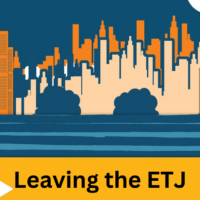“Please Release Me, Let Me Go!”

Previously, our office blogged about what an ETJ is. To recap, the extraterritorial jurisdiction (ETJ) is the legal authority that a city holds to regulate and make decisions in areas that are outside of its formal city limits, but still within a designated surrounding boundary. The ETJ allows a city to plan for future growth and development in areas adjacent to its boundaries.
However, what happens when a landowner wants to be released from a city’s ETJ? In Texas, without the requirement of an election, being released from the ETJ involves a formal process found in the Texas Local Government Code, Chapter 42, Subchapter D as newly added by Senate Bill 2038 from the 88th Regular Legislative Session. Some landowners might seek release from the ETJ because they dislike being regulated by a city when they cannot vote in city elections and have no say in the regulations. However, following release from the city’s ETJ, the area will revert to county jurisdiction, and be subject to county regulations.
Petition for Release: A petition is required to initiate the process of release from the ETJ. The petition must be submitted to the City and may be submitted by a resident or landowner in the area to be released. The petition must be signed by more than one-half of the registered voters in the area to be released, or by a majority of the title owners of land in the area. That majority must be a majority in value as indicated by the appraisal rolls of the county. A petition for an area with only one owner would contain only one person’s signature. The petitioners have 180 days to gather the appropriate number of signatures and file the petition.
Map and Legal Description Required: The petition must include a map of the area to be released from the ETJ, and it must describe the boundaries of the land to be released by metes and bounds or lot and block, if there is a recorded map or plat.
Verify the Signatures: The city secretary is responsible for verifying the signatures on the petition received by the city, pursuant to Chapter 277 of the Election Code. Each signature must include the signer’s printed name, date of birth or voter registration number, residence address and date of signing. Only the signature itself must be in the signer’s own handwriting. After the city secretary’s review and verification of the signatures, the city must notify the petitioner as to the sufficiency of the petition no later than the fifth regular business day after its receipt of the petition.
Review the Petition: The city’s review of the petition should ensure it complies with all the requirements of Chapter 42, Subchapter D. The requirement to notify the petitioners regarding the sufficiency of petition may be met by notifying the person who submitted the petition.
To Release or Not to Release: If the petition satisfies all the previous requirements, the city has no choice but to release the area from the ETJ. 42.105(c) requires the city to “immediately release” the area from the ETJ. The city must take action to release the area, and if it does not do so by the later of a) the 45th day after receipt of the petition or b) the next city council meeting that occurs after 30 days after the city’s receipt of the petition, then the area is automatically released by operation of law. Best practice would be to release the area by ordinance so that the city has a historical record and can revise its maps.
Some cities are developing their own documents regarding release from the ETJ, combining the provisions of Chapter 42 of the Local Government Code and Chapter 277 of the Election Code. It is advisable for a landowner to contact the city’s planning or zoning department to discuss the release process and gather information on the specific requirements and procedures.
Please do not rely on this article as legal advice. We can tell you what the law is, but until we know the facts of your given situation, we cannot provide legal guidance. This website is for informational purposes and not for the purposes of providing legal advice.
